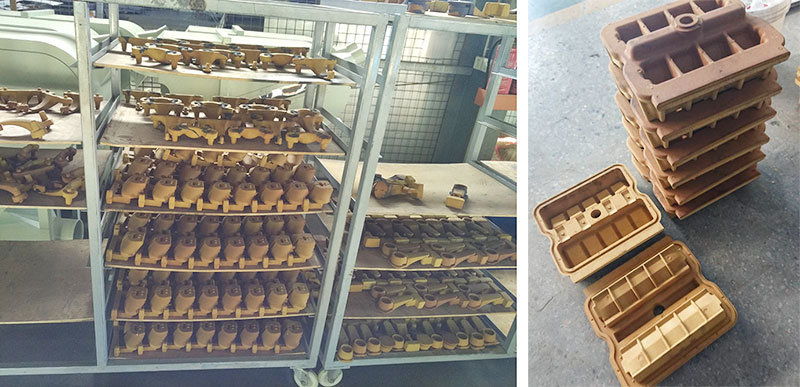Features and problems of coated sand casting process

The coated sand casting process has a long history of use in the casting field. Many companies use the coated sand casting process to produce a large number of castings. However, the use of coated sand casting to produce precision steel castings also has its characteristics and some shortcomings, which deserves our deep consideration.
Features and problems of the coated sand casting process
First. Features of the coated sand casting process:
①The coated sand process has good strength performance;
②Good fluidity, the produced sand mold and sand core have a clear outline and dense organization, and can produce complex sand core;
③The sand mold (core) has good surface quality, the surface roughness can reach Ra=6.3~12.5μm, and the dimensional accuracy can reach CT7~CT9 level;
④The disintegration is good, and the castings are easy to clean.
⑤The coated sand can be used to make both casting molds and sand cores. The coated sand molds or cores can be used together with other sand molds (cores);
⑥It can be used not only for metal-type gravity casting or low-pressure casting, but also for iron-type sand-covered casting, but also for thermal centrifugal casting;
⑦It can be used not only for the production of cast iron and non-ferrous alloy castings but also for the production of steel castings.
Second. There are many problems in the application of coated sand casting processes and solutions to the core manufacturing methods. In general, it can be divided into two categories: thermosetting methods and cold curing methods.
The core of coated sand is thermosetting methods. The equipment is a coated sand core shooting machine, Any kind of core-making method has its own advantages and disadvantages, which mainly depend on comprehensive factors such as product quality requirements, complexity, production volume, production cost, product price and other factors to decide which core-making method to use.
It is very effective to use coated sand to make sand cores with high requirements on the surface quality of the casting cavity, high dimensional accuracy and complex shapes.
For example, car inlet and exhaust passage sand core, water passage sand core, oil passage sand core, cylinder body water passage sand core, oil passage sand core, shell core sand core of intake manifold, exhaust manifold, Sand core of hydraulic valve, the sand core of automobile turbocharger, etc. However, some problems are often encountered in the use of coated sand. Delin Machinery shares some points with you here.
1. The method for determining the strength and gas yield of the coated sand. On the premise that the quality of the original sand and the resin are fixed, the key factors affecting the strength of the coated sand are mainly the amount of phenolic resin added.
When the amount of phenol resin added is large, the strength is increased, but the amount of gas generation is also increased, and the collapsibility is reduced.
Therefore, in production and application, the strength of the coated sand must be controlled to reduce the amount of gas generated and improve the collapsibility, and a balance must be found when the strength standard is formulated.
This balance point is to ensure the surface quality of the sand core and the strength under the premise of no deformation or core breakage during pouring.
In this way, the surface quality and dimensional accuracy of the casting can be ensured, the amount of gas generation can be reduced, the blowhole defects of the casting can be reduced, and the sand production performance of the sand core can be improved.
For the storage of sand cores, station tools and sand core trolleys can be used in the process of transportation, and a sponge with a thickness of 10 mm to 15 mm is laid on it so that the loss rate of the sand core can be reduced.
2. Storage period of coated sand cores: Any sand core will absorb moisture, especially the relative humidity of the air in the southern region is large, the storage period of the sand core must be specified in the process documents, use lean production first-in-first-out production methods to reduce the storage volume and storage cycle of sand cores. Each enterprise should determine the storage period of the sand core by combining its own plant conditions and local climatic conditions.
3. Control the supply quality of the coated sand: The coated sand must be accompanied by the supplier’s quality assurance data when entering the factory, and the enterprise should check according to the sampling standard.
4. Qualified coated sand found that the sand core fractured and deformed during core making. The core sand’s fractured deformation during core manufacturing was usually considered to be caused by the low strength of the coated sand.
In fact, the fracture and deformation of the sand core will involve many production processes in the coated sand casting process. If an abnormal situation occurs, the real cause must be found before it can be completely resolved. The specific reasons are as follows:
1) The mold temperature and mold retention time during core making are related to whether the hardened thickness of the sand core crust meets the process requirements. The process parameters specified in the process all need to have a range, and this range needs to be adjusted by the skill of the operator.
The mold retention time can be taken as the lower limit when the mold temperature is at the upper limit, and the mold retention time can be taken as the upper limit when the mold temperature is at the lower limit. Operators need continuous training to improve their operation skills.
2) Phenolic resin and sand will stick to the mold during core making, which must be cleaned in time and sprayed with a release agent, otherwise, the sand core will be broken or deformed when the mold is opened.
3) The spring mandrel on the static mold of the hot core box mold will cause elastic failure due to long-term working at high temperature, which will cause the sand core to break or deform. The spring must be replaced in time.
4) The moving mold and the static mold are not parallel or not on the same centerline. When the mold is closed, under the pressure of the oil cylinder or the cylinder, there is a slope at the front end of the positioning pin. The mold will still return to its original state, causing the sand core to break or deform. In this case, the sand will run away when the sand is shot, and the size of the sand core will become larger. The solution is to adjust the parallelism and coaxiality of the mold in time.
5) When the hollow sand core is produced on the shell core machine when the unhardened coated sand is poured from the sand core and needs to be reused, it must be sieved and the unused coated sand is mixed at a 3:7 ratio and used. Only in this way can the surface quality and core strength of the core sand core be ensured.
Delin Intelligent Technology Co., Ltd. specializes in the production of the coated sand casting process equipment, which is a coated sand core shooting machine. It is a machinery manufacturing enterprise integrating scientific research, design, manufacturing, installation, debugging and consulting services.
